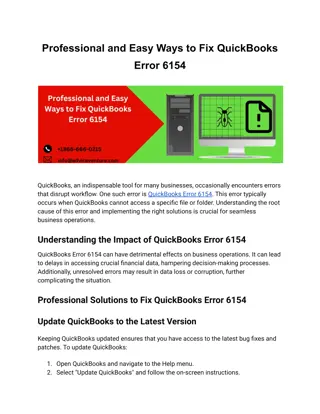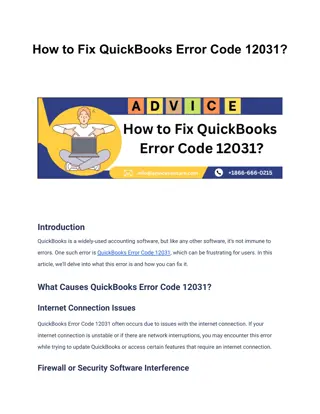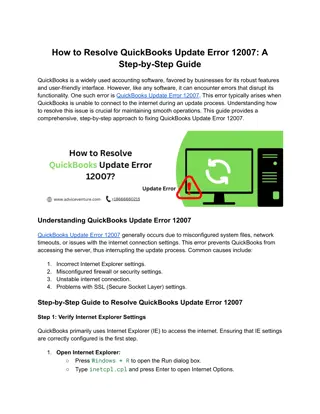Learning From Error
Understanding the nature of errors in healthcare is crucial for improving patient safety. By learning from errors such as commission, omission, and violations, healthcare professionals can implement strategies to reduce mistakes and enhance overall care quality. Mistakes, near misses, and hindsight bias play roles in error perception, emphasizing the importance of analyzing adverse events to prevent future occurrences. Developing a culture that acknowledges and learns from errors is essential for ensuring optimal patient outcomes.
Download Presentation

Please find below an Image/Link to download the presentation.
The content on the website is provided AS IS for your information and personal use only. It may not be sold, licensed, or shared on other websites without obtaining consent from the author.If you encounter any issues during the download, it is possible that the publisher has removed the file from their server.
You are allowed to download the files provided on this website for personal or commercial use, subject to the condition that they are used lawfully. All files are the property of their respective owners.
The content on the website is provided AS IS for your information and personal use only. It may not be sold, licensed, or shared on other websites without obtaining consent from the author.
E N D
Presentation Transcript
Learning From Error Ruaim Muaygil, MD, MBE, HEC-C, PhD Assistant Professor, Health Care Ethics Consultant, Clinical Ethics
A 21-year-old male was being treated for non- Hodgkins lymphoma. A syringe containing vincristine for another patient had been accidentally delivered to the patient s bedside. A physician administered vincristine via a spinal route, believing it was a different medication. The error was not recognized and the patient died three days later.
Objectives Understand the nature of error. Explain the terms: error, violation, near miss, hindsight bias. Learn from errors through: Analyzing adverse events. Practicing strategies to reduce errors. Understand how learning from error improves patient safety.
What do we mean by error? Non-deliberate deviation from what was intended: When someone is trying to do the right thing, but actually does the wrong thing. Fancy definition : A planned sequence of mental or physical activities that fails to achieve its intended outcome, when this failure cannot be attributed to a systematic failure.
Errors may occur through: Commission: doing the wrong thing Omission: failing to do the right thing. Violations: errors caused by a deliberate deviation from an accepted protocol or standard of care.
Errors and Outcomes Errors and outcomes are not always linked: A patient may have a bad outcome without human error (e.g. well-recognized complications.) Some errors do not result in bad outcomes (e.g. not severe, caught in time.) Near miss: an incident that did not cause harm. Still, bad outcomes usually draw attention to errors. Hindsight bias: the nature of the outcome influences perception of the error. Knowing an error has occurred negatively affects our perception of the standard of care before and during the incident in question.
Silly Mistakes? We often commit silly mistakes in our daily lives (forget our keys, text the wrong person.) These same mental processes that lead to silly mistakes are in play in the health care setting. The consequences, however, are very different: it is the patient who suffers. Culture of infallibility: medical culture often denies the prevalence of error.
Patterns of Error Errors occur as a result of two main types of failures: 1. Error of execution: actions do not go as intended: Slip: if this action is observable (e.g. accidently pressing wrong button.) Lapse: if it is not (e.g. forgetting to administer a medication.) 2. Mistakes : a failure of planning: Rule based: a wrong rule is applied. (e.g. wrong diagnosis leads to wrong treatment plan.) Knowledge based: the clinician does not know the correct course of action. (e.g. in new situations.)
Situations That Increase the Risk of Error 1. Unfamiliarity with a task: Students/ junior doctors performing a procedure for the first time Should be practiced on an educational aid. If performed on a patient, must be closely supervised. 2. Shortage of time: Might result in cutting corners and taking shortcuts (e.g. not washing hands properly.)
Situations That Increase the Risk of Error 3. Inadequate checking: Proper checking techniques ensure patients receive the correct medications. 4. Poor procedures: Inadequate preparation (sterilization, equipment.) Inadequate staffing. Inadequate attention to the particular patient.
Individual Factors That Predispose to Error 1. Limited Memory Capacity: Guidelines and protocols assist clinicians to provide care following the best available evidence. Checklists not memory. 2. Fatigue: Known factor in errors. Many countries are reforming the excessive hours worked by doctors. 2004 study: measured the effects of sleep deprivation on medical errors, interns working in the MICU and CCU made substantially more serious mistakes when they worked frequent shifts of 24 hours or more than when they worked shorter shifts.
Individual Factors That Predispose to Error 3. Stress, hunger, illness: Clinicians must monitor their own well being. 4. Language or cultural factors: Communication errors caused by language and cultural factors. Many patient doctor interactions occur without an interpreter or understanding of the language. 5. Hazardous attitudes: E.g. being more interested in practicing or getting experience than having concern for the patient s well-being.
Learning From Error 1. Incident reporting: Collecting and analyzing information about any event that harmed or could have harmed a patient. An incident-reporting system allows the health organization to identify and eliminate error traps . Organizations with a strong reporting culture learn from errors because staff report problems without fear of ridicule or reprimand. Successful reporting strategies: Anonymous reporting. Timely feedback. Open acknowledgement of successes resulting from reporting.
2. Root cause analysis: A highly structured system approach to incident analysis that is generally reserved for the most serious patient harm episodes. Goal is to evaluate, analyze and develop system improvements for the most serious adverse events. Triages the reported incidents to ensure those indicating the most serious risk to the organization are dealt with first. Prevention- not blame or punishment. Systems level vulnerabilities, not individual performance. Multiple factors: communication, training, fatigue, scheduling, rostering, environment, equipment, rules, policies and barriers.
Root Cause Analysis Defining characteristics: Review by an interprofessional team knowledgeable about the processes involved in the event. Analysis of systems and processes rather than individual performance. Deep analysis using what and why probes until all aspects of the process are reviewed and contributing factors are considered. Identification of potential improvements that could be made in systems or processes to improve performance and reduce the likelihood of such adverse events or close calls in the future
Practice Strategies to Reduce Errors Know yourself (eat well, sleep well and look after yourself). Know your environment. Know your task(s). Preparation and planning (What if...). Build checks into the routine. Ask if you do not know.
Practice Strategies to Reduce Errors Assume that errors will be made. Be prepared for them. Identify those circumstances most likely to lead to errors. Have contingencies in place to cope with problems, interruptions and distractions. Always mentally rehearse complex procedures or if it is the first time you are doing an activity involving a patient.
Helpful Tips Avoid reliance on memory. Simplify processes. Standardize common processes and procedures. Routinely use checklists. Decrease the reliance on vigilance.
A 78 year old woman who is blind and deaf without speech is admitted to the hospital clutching her abdomen and moaning. She had been like that for a couple of hours and had also vomited a few times. On examination she had some epigastric tenderness, her heart and lungs were normal, and her blood pressure was slightly low. Routine blood investigations were normal. She is given anti-spasmodic drugs but a few hours later she is still in severe pain. An ultrasound scan ruled out problems with the patient's gallbladder. An endoscopy on the following day produced negative results. On the fifth day, the patient died: the causes undiagnosed, her suffering unrelieved. As the resident prepares to write a case summary, he discovers the patient s ECG- performed on the date of admission but never checked by the team- showing textbook signs of an extensive acute myocardial infarction. Horrified, the resident shows the tracing to the consultant who says making a fuss about this won't bring her back.

























